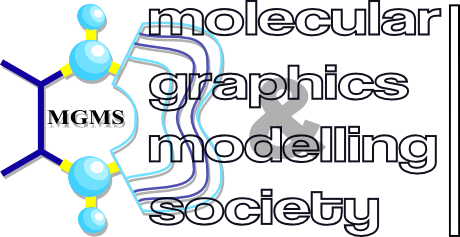Poster Session I
Monday, 4th April, 17:15
|
| |
| P01 |
Christian R. Wick |
Semiempirical MO-Theory for Large Systems |
Abstract |
| |
| P02 |
Birgit J. Waldner |
From Substrate Specificity to Small Molecule Specificity |
Abstract |
| |
| P03 |
Stevan Aleksić |
Dynamic regulation of Ca2+ binding to Langerin carbohydrate recognition domain ay an allosteric network |
Abstract |
| |
| P04 |
Joulia Alizadeh-Rahrovi |
Human apo-myoglobin structural stability in the presence of ligands: a molecular dynamics study |
Abstract |
| |
| P05 |
Thomas Asche |
Performance of the COMPASS force field for inorganic-organic hybrid polymers |
Abstract |
| |
| P06 |
Frank Beierlein |
DNA-dye-conjugates: conformations and spectra of fluorescence probes |
Abstract |
| |
| P07 |
Zlatko Brkljača |
Biomineralization and biomineralization-inspired drug design: Calcite – peptide interactions |
Abstract |
| |
| P08 |
Karina van den Broek |
Mesoscopic simulation of the membrane disrupting activity of the cyclotide Kalata B1 |
Abstract |
| |
| P09 |
Markus Dick |
Trading off stability against activity in extremophilic aldolases |
Abstract |
| |
| P10 |
Benedikt Diewald |
Design of antibody-based peptide inhibitors to disrupt important protein-protein interactions in HIV and HCMV |
Abstract |
| |
| P11 |
Luca Donati |
Markov State Models with reweighting |
Abstract |
| |
| P12 |
Mirja Duderstaedt |
Dynamic generation of inorganic and organic polymer structures in hybrid polymers |
Abstract |
| |
| P13 |
Christiane Ehrt |
Ligand-sensing cores – Large Scale Analysis and Application |
Abstract |
| |
| P14 |
Holger Elsen |
Mechanistical Insight on the Hydrosilylation of Conjugated Alkenes Catalyzed by Early Main-Group Metal Catalysts |
Abstract |
| |
| P15 |
Marko Hanževački |
Investigation of the effect of β-Cyclodextrin on Peptide Deamidation: A Molecular Dynamics Study |
Abstract |
| |
| P16 |
Susanne M.A. Hermans |
Towards Identifying Novel Allosteric Drug Targets using a “Dummy” Ligand Approach |
Abstract |
| |
| P17 |
Anselm H. C. Horn |
Conformational Stability of Non-Fibrillar Amyloid-β17-38 – A Molecular Dynamics Study |
Abstract |
| |
| Please remember to remove your poster afterwards! |
| |
Poster Session II
Tuesday, 5th April, 17:15
|
| |
| P01 |
Lina Humbeck |
Discovery of a novel relationship between two proteins by a chemogenomics analysis |
Abstract |
| |
| P02 |
Patrick Kibies |
Electronic polarization induced by high solvent pressure |
Abstract |
| |
| P03 |
Zoran Miličević |
The Role of Water in the Electrophoretic Mobility of Hydrophobic Objects |
Abstract |
| |
| P04 |
Zahrabatoul M. Kotena |
Bifurcated hydrogen bondin in carbohydrate sugars |
Abstract |
| |
| P05 |
Jan L. Riehm |
The many faces of Cyp106A2: How does rational protein design work |
Abstract |
| |
| P06 |
Achim Sandmann |
Different Types of Ca2+ binding sites in SiiE |
Abstract |
| |
| P07 |
Cenk Selçuki |
Conformational analysis of neutral and ionic forms of lysine |
Abstract |
| |
| P08 |
Dmitry I. Sharapa |
Pitfalls in the accurate determination of non-covalent interaction energies in large systems using the example of the C60 dimer |
Abstract |
| |
| P09 |
Eileen Socher |
Investigation of pH-dependent effects on proteins by mimicking pH titration experiments with MD simulations |
Abstract |
| |
| P10 |
Anne Steimecke |
In silico screening and testing of new phytoeffectors to enhance drought stress tolerance in plants |
Abstract |
| |
| P11 |
Maxim Tafipolsky |
Challenging Dogmas: What is inside a Hydrogen Bond? |
Abstract |
| |
| P12 |
Nicolas Tielker |
Transfer free energies between aqueous and nonaqueous phases from an integral equation-based quantum solvation model |
Abstract |
| |
| P13 |
Martin Urban |
Molecular gating characteristics in variant of the potassium ion channel KcvATCV |
Abstract |
| |
| P14 |
Nataša Vučemilović-Alagić |
Organization and Wetting of [C4Mim][Ntf2] Ionic Liquid at the Neutral Sapphire Interface |
Abstract |
| |
| P15 |
Nursel Acar |
Computational investigation of the exciplexes formed between pyrene and selected monoamines |
Abstract |
| |
| P16 |
Nursel Acar |
DFT and TDDFT study some pyrene derivatives in excited state |
Abstract |


